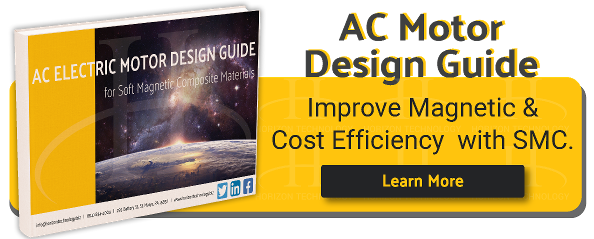There’s no question soft magnetic composites (SMCs) offer value to the efficiency, size, weight and performance of electrical machines. As industries continue to become more electrified and harness the gains of SMCs, we have to look to the future and ask ourselves, are SMCs sustainable? How do they contribute to the circular economy of an electric motor?
Soft Magnetic Composites For A Sustainable Future
Until recently, conventional manufacturing hasn’t considered the sustainability aspects of their production, but did you know the powder metal industry is actually a metalforming technology with well-established sustainability practices already in place?
Truths About Sustainability of Powder Metal & SMCs
Think the powder metal industry is just for making low-cost products? Think again – using powder metallurgy to manufacture structural and SMC products is a highly engineered process that supports a wide variety of applications, from automotive, to HVAC, household appliances, and beyond.
Less Waste/True Recycling
Over 75% of powder metallurgy parts begin with raw materials manufactured from recycled scrap steel. Once produced, these powders are used in a material efficient compaction/sintering process, with less than 3% waste. The minimal scrap material generated can be recycled back into components or raw material. The same green manufacturing technology is also applicable in SMC devices, unlike laminations, where the need to stamp and discard material is a necessary and wasteful requirement.
Energy Efficient: Part Production to End-of-Life of an SMC Device
Manufacturing a component with PM is 15% less energy intensive than manufacturing a component from steel laminations, however this is just the beginning of the energy savings you may realize. SMC parts are more energy efficient (lower core losses) and need less cooling, extending battery range. These inherent attributes of SMCs lower the overall operational cost, thus reducing the carbon footprint of the device from start of production to end-of-life.
Added Benefits For Improved Motor Topologies
SMCs in motor applications provide further sustainability advantages. Using them in an axial flux motor topology provides an opportunity to use sustainable materials, while improving performance.
Soft magnetic composites also allow for simplified manufacturing and reduced cost of various motor topologies – instead of using a high cost neodymium iron boron magnet in your next motor design, you could use lower cost neodymium iron boron magnet or even a ferrite magnet in conjunction with SMCs.
Now let’s examine what happens to an SMC at the end of its life.
SMCs: Providing a Circular Economy for Today’s Motor
The next time you go to throw away your junk motor, remember: unlike steel laminations, a motor manufactured with SMCs can be placed in a simple jaw crusher to easily separate and reuse copper and other high-value materials – which is significantly less labor intensive and more prone to recyclability.
To learn more about how SMCs can increase the sustainability of your production, check out our free e-book: “AC Electric Motor Design Guide: Soft Magnetic Composites.”



